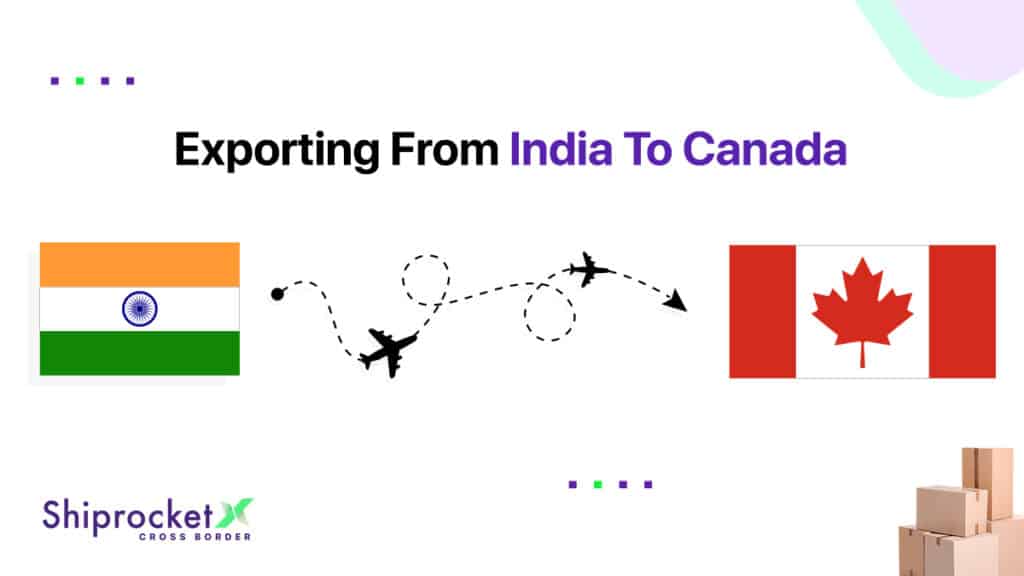How To Export To Canada From India: A Practical Guide
Indo-Canadian relations have always been at a pleasant pitch for a long period. Did you know that at least 4% of the Canadian population is of Indian origin? Canada is one of the few foreign countries home to one of the largest Indian communities globally and the largest source of non-resident students from India since 2018. Thus, it doesn’t surprise that the country is deemed a potential export partner for India. For the last 4 to 5 years, Canada has emerged as one of the wealthiest nations among 195 countries in eCommerce trade. Canada was recently added to India Post’s International Tracked Packet System (ITPS) list to facilitate efficient and effortless eCommerce exports to the country.
Let’s discuss what Canada imports from India and why you should export to Canada.

Items Exported To Canada
In recent years, the relationship between the two countries has not stayed limited to just residential or educational purposes but has diversified to include Make In India products as exports into the Great White North.
In 2022, India was Canada’s 10th largest trading partner, making it a priority market for Canada. As Canada enhances its economic ties to the Indo-Pacific region, India will play a key role. Canada and India are working on a Comprehensive Economic Partnership Agreement and a Foreign Investment Promotion and Protection Agreement (FIPA). Both countries are also committed to holding regular Ministerial Dialogues on Trade and Investment to find ways to strengthen their commercial relationship. Some of the prime items exported into Canada include:
- Steel and Iron Products
India is a major exporter of steel and iron products to Canada. These materials are crucial for industrial, infrastructure, and construction projects. High-quality Indian steel and iron are used to build skyscrapers, bridges, and other important structures.
- Organic Chemicals
India supplies essential organic chemicals for various Canadian industries, including manufacturing, agriculture, and pharmaceuticals. These chemicals are vital for making fertilizers, medications, and other products. India’s expertise in chemical synthesis ensures a steady supply of high-quality organic chemicals to Canada.
- Precious Stones, Metals, and Pearls
Indian precious stones, metals, and pearls are highly valued in Canada for their excellent quality. These luxury items are used in jewellery, decoration, and industrial applications. Their fine craftsmanship and the availability of precious materials contribute to their high export value.
- Pharmaceutical Products
Indian pharmaceutical products are popular in Canada due to their low cost and high quality. These include various generic medications and active pharmaceutical ingredients used to treat different medical conditions. Indian pharmaceutical companies are trusted in Canada’s healthcare sector for their affordable prices and strict quality standards.
- Machinery Parts
India exports machinery parts, boilers, etc. to Canada for use in industrial and energy sectors. These products are essential for heavy engineering, manufacturing, and energy production. Indian machinery is known for its affordable prices and advanced technology, making it reliable and efficient for Canadian businesses.
- Automobiles
Indian automobiles, including passenger and commercial vehicles, are increasingly popular in Canada. The Indian auto industry produces high-quality vehicles at affordable prices, meeting diverse transportation needs in the Canadian market.
- Textile Items and Used Clothes
Indian textiles and apparel are well-regarded in Canada for their quality and variety, including traditional and modern styles. These products appeal to Canadian consumers who value sustainability and fashion. India’s renowned textile industry offers diverse fabrics, intricate patterns, and sustainable production methods.
- Handicrafts and Decorative Items
Indian handicrafts and decorative items are appreciated in Canada for their cultural richness and intricate designs. These include handmade jewellery, textiles, pottery, and home furnishings. Indian crafts highlight the country’s artistic heritage and skilled craftsmanship, appealing to Canadians who value cultural diversity and artistic excellence.
- Electronic and Electrical Equipment
India exports a wide range of electronic and electrical equipment to Canada. These include components for the tech industry, industrial machinery, and consumer electronics. India’s growing expertise in electronics manufacturing ensures a consistent supply of advanced, high-quality products for the Canadian market.
- Knit and Crochet Clothing
Indian knit and crochet clothing are favoured in Canada for their quality and affordability. They range from casual wear to high-end designer items. Indian artisans use intricate techniques to create stylish, durable, and comfortable clothing that appeals to Canadian consumers.
- Tea, Coffee, and Spices
Indian tea, coffee, and spices are in high demand in Canada for their unique flavours and health benefits. These products are widely used in Canadian kitchens for cooking, brewing, and seasoning, adding rich flavours to dishes and beverages.
- Grains
Indian grains, particularly rice and wheat, are staples in the Canadian diet. Indian basmati rice is prized for its distinctive aroma and long grains, while Indian wheat is used to produce various baked goods and cuisines.
- Leather Products
High-quality Indian leather goods, such as accessories, handbags, and shoes, have a significant market in Canada. These products are stylish and practical and are known for their durability, exquisite designs, and superior quality.
Items Banned From Exporting
Trade between the two nations has faced some challenges, including trade barriers, regulatory issues, and concerns related to intellectual property rights. These challenges have been the subject of discussions in trade negotiations.
While the country is on lenient terms with our nation in importing products, the Canadian government has some universal bans on exporting a few items from any part of the world, including India. Let’s check what these prohibited items are:
- Baby Walkers: Baby walkers are banned from importing into the country because of the persistent risk of baby injury.
- Magic Candles: Magic candles, also known as relight candles, have a very high risk of inducing fire hazards, so they’re banned from being imported from other countries.
- Self-feeding Devices: Self-feeding devices pose a choking hazard threat in the hands of infants.
- Long Yo-Yos: These are generally fatal in the hands of children, especially ones 20 inches or more in length, as they have high strangulation risks.
- Balloon Blowers: Not known to most common folk, balloon blowers have a high chance of containing toxins in them, which is hazardous for health in the long run.
- Jequirity Beans: Jequirity beans are herbaceous flowering plants whose consumption is fatal as the seeds are highly poisonous.
- Weapons and Ammunition: You cannot export firearms, explosives, and certain types of ammunition.
- Drugs: Narcotics, psychotropic substances, and drugs not approved by Health Canada are not allowed for export.
- Food: Fresh fruits and vegetables are banned because they can introduce pests and invasive species.
- Counterfeit Goods: Fake or pirated items cannot be exported.
- Endangered Species: Endangered species and anything made from the parts of endangered species (as found in some souvenirs) are prohibited.
- Hazardous Materials: Corrosive materials and nuclear and oxidising substances are banned from exporting.
- Other Items: You cannot export chain letters, contraceptive devices, hate propaganda, obscene matter, poisonous substances, prison-made goods, used beekeeping apparatus, margarine, gold bullion, and metallic labels.
Other than the former prohibitions, a few products have restricted entry into Canada and need special permission to enter Canada. Here’s what you need to know:
Food Restrictions
- Items: Nuts, grains, seeds, fresh produce, dried foods.
- Entry of these items is Governed by the Automated Import Reference System (AIRS).
To export these items to Canada, you must input the product code, origin, and destination, and provide a list of required documents. Always consult the National Import Service Centre for more details.
Firearm Restrictions
- Documents Needed for these items:
- Possession and Acquisition Licence.
- Canadian Firearm Registration Certificate or Form RCMP 5589.
- Authorisation to Transport.
- Fee: CAN$25.00.
- Types of Restricted Firearms:
- Most handguns.
- Semi-automatic rifles and shotguns with barrels between 105 mm and 470 mm.
- Firearms that can be shortened to less than 660 mm in length.
Vehicle Restrictions
- Regulated by: Registrar of Imported Vehicles (RIV).
- Steps to Follow:
- Gather vehicle information.
- Determine the point of entry.
- Check entry requirements with the Canada Border Services Agency (CBSA).
- This is to verify vehicle eligibility and understand the duties and taxes involved.
Why Should You Export To Canada?
The annual export gains for Canada from India stand at 39 to 47%, while the export benefits are at 32 to 60% for India. In the last couple of years, India made the maximum exports in the following categories: cotton fabrics, drugs and pharmaceuticals, chemicals, steel and marine products.
India was the sixth-largest exporter of apparel and other textile products 2017. Since then, Indian exports have increased at a 3% rate yearly. In 2022, apparel exports comprised India’s 50% exports into Canada, home textiles at another 50% and fabrics at 8% of total exports.
Considering India is making the highest textile exports in 2022, this is perhaps the best time to have an active presence amongst Canadians, focusing on the links between the increasing Indian population and situational buyer demand changes.
Bilateral trade relations have been growing steadily over the years. Both countries have sought to enhance economic cooperation through trade agreements and negotiations.
India and Canada have also seen increasing investments from each other. Indian companies have invested in various sectors in Canada, including IT, pharmaceuticals, and natural resources. Canadian companies have also shown interest in the Indian market.
Charting a Seamless Shipping Journey with Shiprocket
ShiprocketX is your go-to solution for managing shipping efficiently in your eCommerce business and if you want to export to Canada. It simplifies the entire process, allowing you to plan deliveries better and join a community of satisfied sellers. ShiprocketX handles all your orders and deliveries, boosting your revenue and keeping your customers happy with timely deliveries, including options like next-day shipping. It enables global expansion, facilitating quick and transparent order fulfillment. ShiprocketX also assists in building trust with customers, engaging them effectively, and streamlining the checkout process. With its extensive network covering over 220 international destinations, including Canada, you can fulfill orders confidently from anywhere, ensuring customer satisfaction worldwide.
Last Word: How Do You Export From India To Canada Seamlessly
You can gain a competitive edge over your exports to Canada by focusing on improved quality of products. With the Indian government providing multiple schemes to help export businesses, now is the right time to start considering methods to start expanding your business to top export countries like Canada.
As part of your R&D, you also need to determine factors like an economic framework, the capital required, the tariffs involved, the behaviour of the customers with your products, and the right ways of shipping your products. Thankfully, it isn’t difficult to start exporting products to different parts of the world anymore with affordable cross-border courier platforms that support budding brands with unified tracking features, minimal documentation hassles, and eCommerce page integrations for its international business partners.






